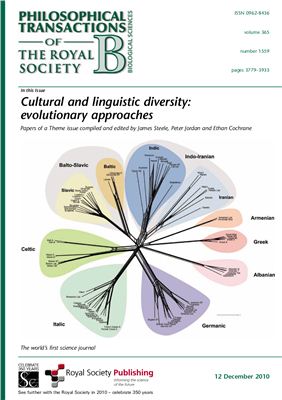Коллектив авторов.
Publication date: December 2010.
Number of pages: 155.
Format / Quality: PDF.
Evolutionary approaches to cultural change are increasingly influential, and many scientists believe that a ‘grand synthesis’ is now in sight (e.g. Mesoudi, Whiten & Laland 2006). At the ‘microevolutionary’ scale, mode theories of cultural evolution recognize that cultural traditions and innovations are socially transmitted person-to-person between and within generations (respectively, by vertical or oblique and by horizontal transmission routes; Cavalli-Sforza & Feldman 1981), with leaers applying generalized rules of thumb in choosing when to engage in independent trial-and-error leaing, and in selecting whose example to copy when this is the preferred strategy (transmission biases; Boyd & Richerson 1985). Preservation of a historical signal within the cultural traditions carried by populations depends on traits being consistently selected and replicated, often with some degree of modification, ensuring that they survive from one generation to the next. Cultural ‘macroevolution’ refers to the historical processes that explain cultural similarities and differences between human populations arising from such repeated copying with modification (Mulder et al. 2006). Mesoudi et al. (2006), who propose a multidisciplinary framework for the Darwinian analysis of cultural dynamics, draw an explicit parallel between evolutionary archaeology, cultural anthropology and comparative anthropology (among the cultural sciences), and the macroevolutionary disciplines in biology (respectively, palaeobiology, biogeography and systematics). Historical linguistics should certainly be added to the list of cultural disciplines with a macroevolutionary focus.
Publication date: December 2010.
Number of pages: 155.
Format / Quality: PDF.
Evolutionary approaches to cultural change are increasingly influential, and many scientists believe that a ‘grand synthesis’ is now in sight (e.g. Mesoudi, Whiten & Laland 2006). At the ‘microevolutionary’ scale, mode theories of cultural evolution recognize that cultural traditions and innovations are socially transmitted person-to-person between and within generations (respectively, by vertical or oblique and by horizontal transmission routes; Cavalli-Sforza & Feldman 1981), with leaers applying generalized rules of thumb in choosing when to engage in independent trial-and-error leaing, and in selecting whose example to copy when this is the preferred strategy (transmission biases; Boyd & Richerson 1985). Preservation of a historical signal within the cultural traditions carried by populations depends on traits being consistently selected and replicated, often with some degree of modification, ensuring that they survive from one generation to the next. Cultural ‘macroevolution’ refers to the historical processes that explain cultural similarities and differences between human populations arising from such repeated copying with modification (Mulder et al. 2006). Mesoudi et al. (2006), who propose a multidisciplinary framework for the Darwinian analysis of cultural dynamics, draw an explicit parallel between evolutionary archaeology, cultural anthropology and comparative anthropology (among the cultural sciences), and the macroevolutionary disciplines in biology (respectively, palaeobiology, biogeography and systematics). Historical linguistics should certainly be added to the list of cultural disciplines with a macroevolutionary focus.

